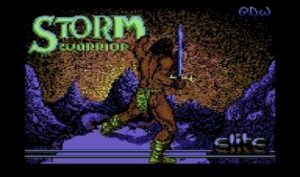Storm Warrior
Qualcuno di voi si ricorderà i tempi in cui i giochi per Commodore 64 (specie se su nastro) giravano come le figurine: dato che non ci si poteva permettere di acquistarne molti, soprattutto se originali, si ricorreva allo scambio… Capitava così di ricevere tra le mani giochi ancora sconosciuti, ma non per questo meno interessanti dei titoli più blasonati e ricercati. E’ il caso di Storm Warrior, che conobbi come “Jungle Warrior” (trattandosi chiaramente di un “crack” made in Italy). La particolarità di questa versione (il titolo originale lo scoprii molti anni dopo grazie alla High Voltage SID Collection) consisteva nella presenza di un “trainer” già incorporato, che forniva energia infinita. Questo consentì a me e mio fratello di goderci non un gioco, bensì una sorta di “dimostrazione interattiva”, un film in pixel accompagnato da una colonna sonora di altissima qualità.
Il gioco (da non confondere con l’omonimo pubblicato nel 1984 da K-Tel International) è opera di Chris Coupe (programmatore), Paul Walker (artista grafico) e Mark Cooksey (musicista), lo stesso team responsabile della versione per Commodore 64 di Forgotten Worlds (come riportato in copertina): pubblicato direttamente in versione economica sotto l’etichetta “Encore” della Elite, strizza l’occhio a titoli come “Barbarian” della Psygnosis e “Rastan Saga” della Taito; il giocatore è chiamato a vestire i panni del principe di un regno sul quale una malvagia strega ha scatenato una terribile maledizione, che sta portando alla distruzione di interi villaggi. Il principe, armato di spada, dovrà raggiungere il castello della strega, attraversando quattro livelli irti di ostacoli e sorvegliati da un esercito di guerrieri al soldo (o meglio, sotto l’influsso dei poteri) del nemico.

Nella schermata dei titoli è possibile scegliere se giocare con la musica o con gli effetti sonori: preferisco quest’ultima scelta, perché in questo modo si ha la possibilità di comprendere in maniera più immediata ciò che avviene nel corso del gioco; tuttavia la musica è l’elemento portante dell’intera esperienza, praticamente l’unica cosa per cui a suo tempo valeva la pena acquistare Storm Warrior.
Il brano di apertura, nella parte iniziale, è pervaso da un’atmosfera lugubre, accentuata dall’assenza di accordi maggiori nella progressione; dopo una breve introduzione l’andamento si fa più cadenzato, fino ad un cambio di tempo, che anticipa un cambio metrico che caratterizzerà il brano fino alla coda, la cui funzione principale, oltre a far riecheggiare le oscure atmosfere iniziali, sembra essere quella di riportare la tonalità e il tempo a quelli dell’introduzione.
Il nostro eroe ha una sola vita a disposizione, e la sua “energia” è rappresentata (in maniera molto originale) dal passaggio, nella parte inferiore dello schermo, della morte in persona: quando il cupo mietitore avrà superato l’albero sulla sinistra, sarà la fine… L’energia dei nemici è invece rappresentata da un numero posto vicino alla relativa rappresentazione grafica negli angoli inferiori dello schermo.
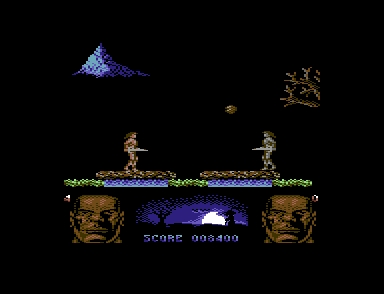
Il primo livello si svolge in una foresta caratterizzata da piccoli corsi d’acqua, alture rocciose ed alberi spogli. La musica che lo accompagna è caratterizzata da una struttura molto semplice: un clavicembalo suona per tutta la durata del brano un arpeggio strutturato come un canone; ad esso si aggiunge dapprima il basso, e successivamente un flauto, che suona due temi, ognuno ripetuto all’ottava inferiore: il primo è abbastanza lineare (impreziosito però da numerosi abbellimenti), mentre il secondo è più articolato. Il clavicembalo ripete poi due volte il motivo del canone (la prima all’ottava superiore), e dopo una nuova esposizione del primo tema da parte del flauto il brano ricomincia dall’inizio.
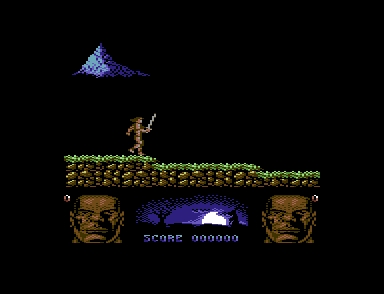
La prima schermata di questo livello non presenta nemici od ostacoli, e dà quindi la possibilità di fare pratica con i comandi: studiare le varie mosse (tre di attacco e due di difesa), oltre ai movimenti di base (chinarsi, saltare e cambiare direzione; si può anche sferrare un calcio agli avversari per poterli allontanare leggermente in modo da averli più facilmente a tiro di spada) è indispensabile per affrontare al meglio il gioco. Il primo combattimento avviene nella schermata successiva, mentre nella terza si dovrà affrontare il primo ostacolo “naturale”, ovvero dei sassi che piovono da un albero (l’unico modo per evitarli è saltare, ma è quasi impossibile uscire incolumi dal loro attacco). Spesso i nemici sono “nascosti” (seppur ben visibili in “trasparenza”): potranno essere colpiti soltanto una volta usciti allo scoperto. E’ importante sapere che – in questo e nel secondo livello – non si può passare alla schermata successiva se prima non si sconfiggono tutti i nemici presenti. Nella decima schermata si dovrà affrontare un mostro verde particolarmente coriaceo: sono necessari quattro colpi per abbatterlo.

Nel secondo livello ci troviamo in una fortezza diroccata, disseminata di nemici e di statue sputa fuoco. La musica è una sorta di omaggio a Johann Sebastian Bach (principale fonte di ispirazione dell’autore, stando alle sue stesse parole): si tratta di una piccola fuga in Re minore, con una struttura armonica molto complessa (che comprende un paio di modulazioni). E’ il mio brano preferito dell’intera colonna sonora. Anche qui dovremo affrontare nemici umani e superare vari ostacoli prima del mostro finale (che però richiederà un colpo in più rispetto al livello precedente).

Il terzo livello è una sorta di “discesa agli inferi”: il brano che accompagna l’azione prende spunto da un passaggio già utilizzato nella musica dello schermo dei titoli ed è caratterizzato da un giro armonico discendente (oltre che da numerosi cambi di tonalità – questa volta a salire, sicuramente per sottolineare l’aumento della tensione!). Non so se Mark Cooksey avesse avuto la possibilità di osservare i vari livelli, ma qui ha fatto davvero un lavoro encomiabile: musica e immagini si sposano alla perfezione! E’ un livello abbastanza facile da superare, dato che non è necessario uccidere i nemici per passare alle schermate successive; bisogna tuttavia fare attenzione alle stalattiti presenti in alcuni punti, che si staccano al passaggio del giocatore.
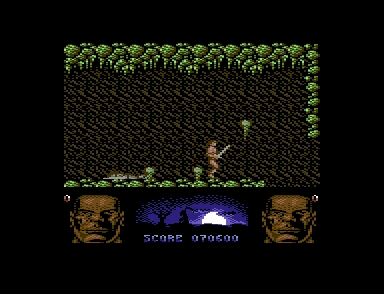
presente nella schermata – prima di lanciarsi nel vuoto!
Nel quarto livello ci troviamo a combattere in una caverna tappezzata di teschi sputa fuoco, ed i cui “piani” sono collegati da piattaforme mobili, in un epico scontro finale sottolineato a dovere da una musica incalzante, caratterizzata da un paio di temi che si ripetono su due tonalità differenti. I nemici possono (anzi, devono!) essere evitati, ma sarà necessario calibrare bene i salti per non essere poi costretti a tornare sui propri passi (esponendosi così ad ulteriori danni causati dalle palle di fuoco che i teschi lanciano a ripetizione, e da cui difficilmente ci si può difendere).
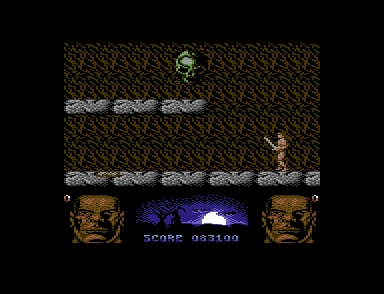
alla sua portata, ed il cupo mietitore non aspetta altro…
Un breve jingle anticipa l’ultima musica del gioco (tralasciando quella del Game Over, che in passato non avevo potuto ascoltare proprio a causa del “trainer”!), un “disco-rock” con una struttura simile a quella della musica del quarto livello (due temi che si alternano su tonalità e ottave diverse) che accompagna la scrittura del nome per la classifica dei punteggi.
Tutto sommato Storm Warrior è un gioco abbastanza breve (quaranta schermate), con una certa varietà di situazioni ed ambientazioni; i combattimenti sono poco interessanti, dato che è sufficiente utilizzare sempre lo stesso colpo per poter sconfiggere i nemici ed uscire praticamente incolumi dallo scontro, mentre ostacoli come le rocce del primo livello e le palle di fuoco del quarto aggiungono quell’elemento di casualità che non tutti apprezzano. Tuttavia la scarsa lunghezza del gioco rende meno frustrante (o meglio, più accettabile) il ricominciare tutto dall’inizio dopo l’ennesimo, fatidico “Game Over”. Si tratta quindi di un gioco bello da vedere e – soprattutto – da ascoltare, ma non molto divertente da giocare: il mio ricordo, infatti, rimarrà legato principalmente alle sue splendide musiche.
